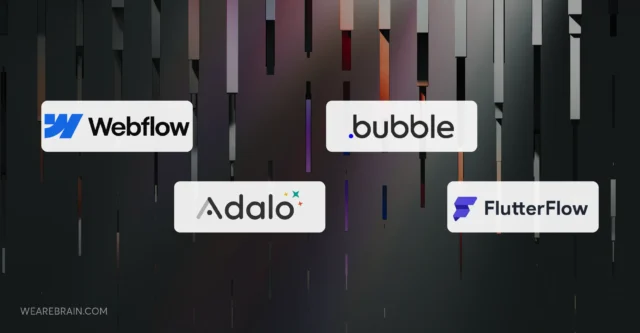
Quick takeaway: Low-code and no-code platforms have revolutionised MVP development, enabling faster market entry and cost-effective validation.
Best platforms by use case:
- Web apps: Bubble (complex logic), Webflow (design-focused)
- Mobile apps: FlutterFlow (cross-platform), Adalo (rapid prototyping)
- Enterprise: OutSystems (scalable, secure)
- Data-driven: Glide (Google Sheets), Softr (Airtable)
Key benefits:
- 70-80% faster development vs traditional coding
- 60% lower costs for MVP development
- Non-technical team members can contribute
- Rapid iteration based on user feedback
Decision factors: Technical skill level, platform requirements (web/mobile), data complexity, budget, and scalability needs.
Bottom line: Choose based on your team’s capabilities and core user journey—speed to market beats perfect code for MVP validation.
The startup graveyard is littered with brilliant ideas that took too long to reach market. Whilst founders obsessed over perfect code and pixel-perfect designs, competitors swooped in with “good enough” solutions that captured users and funding. The harsh reality? Speed trumps perfection when you’re validating a new concept.
This is where low-code and no-code platforms become game-changers. They’ve evolved from simple form builders into sophisticated development environments capable of creating genuine, scalable products. The question isn’t whether you should consider them for your MVP—it’s which platform will get you to market fastest whilst meeting your specific needs.
The MVP development landscape has shifted dramatically. What once required months of backend development, frontend coding, and database architecture can now be assembled in weeks using visual interfaces and pre-built components.
Why you need a low-code approach for your MVP
Traditional development approaches often become bottlenecks for early-stage validation. Here’s why low-code platforms make sense for MVP development:
- Speed to market: Launch in weeks instead of months, capturing market opportunities before they vanish
- Cost efficiency: Significantly lower development costs compared to custom coding from scratch
- Iteration flexibility: Make changes quickly based on user feedback without extensive redevelopment
- Resource optimisation: Allow non-technical team members to contribute meaningfully to product development
- Risk reduction: Test concepts with minimal upfront investment in development resources
- Focus on validation: Spend time understanding users rather than debugging code
Understanding the low-code spectrum
Before diving into specific platforms, it’s crucial to understand the distinction between low-code and no-code solutions. This isn’t just marketing terminology—it affects which platform suits your team’s capabilities and project requirements.
No-code platforms require zero programming knowledge. They’re perfect for founders, marketers, and designers who want to build functional products without touching code. These platforms use visual interfaces, drag-and-drop components, and pre-built templates to create applications.
Low-code platforms assume some technical familiarity. They offer more customisation and power but may require basic programming concepts or the ability to work with APIs and databases. They’re ideal for developers who want to accelerate development without sacrificing flexibility.
The beauty of modern low-code platforms lies in their sophistication. Today’s solutions can handle complex workflows, integrations, and user management—capabilities that previously required extensive custom development.
Top platforms transforming MVP development
Bubble: The powerhouse for complex web applications
Bubble stands out for its ability to create genuinely sophisticated web applications without code. Unlike simple website builders, Bubble handles complex logic, user authentication, payments, and database relationships through its visual programming interface.
Key strengths:
- Advanced workflow automation
- Robust database management
- Extensive API integration capabilities
- Strong community and plugin ecosystem
Best for: SaaS products, marketplaces, and web applications requiring complex user interactions and data management.
FlutterFlow: Mobile-first development
FlutterFlow bridges the gap between rapid development and native mobile performance. Built on Google’s Flutter framework, it generates actual Flutter code that you can export and customise further.
Key strengths:
- True cross-platform mobile development
- Firebase integration for backend services
- Exportable, readable code
- Real-time collaboration features
Best for: Mobile-first startups and teams wanting native performance without platform-specific development.
Webflow: Design-driven web development
Webflow empowers designers to create production-ready websites and simple web applications. Its visual CSS editor and CMS capabilities make it particularly strong for content-driven products and marketing sites.
Key strengths:
- Pixel-perfect design control
- Built-in CMS and hosting
- SEO optimisation tools
- E-commerce capabilities
Best for: Content platforms, portfolios, and businesses needing sophisticated marketing websites with light application features.
Adalo: Rapid mobile prototyping
Adalo focuses specifically on mobile app creation with an emphasis on speed and simplicity. Its component marketplace and templates accelerate development for common app patterns.
Key strengths:
- Intuitive mobile-first interface
- Component marketplace
- Progressive web app support
- Simple database management
Best for: Consumer mobile apps and simple business applications requiring quick market validation.
Enterprise and specialised solutions
OutSystems: Enterprise-grade low-code
For teams needing enterprise features and scalability from day one, OutSystems provides a comprehensive low-code environment with advanced security, integration, and deployment capabilities.
Key strengths:
- Full-stack development capabilities
- Enterprise security and compliance
- AI-assisted development
- Robust deployment options
Best for: B2B products requiring enterprise features and teams planning significant scale from launch.
Glide and Softr: Data-driven applications
These platforms excel at turning existing data into functional applications. Glide transforms Google Sheets into mobile apps, whilst Softr builds web applications using Airtable as the backend.
Key strengths:
- Rapid deployment from existing data
- Cost-effective for simple use cases
- Easy maintenance and updates
- Perfect for internal tools
Best for: Internal business tools, simple customer portals, and MVPs built around existing data structures.
Making the right platform choice
Selecting the optimal platform requires honest assessment of your project requirements and team capabilities. Start by defining your MVP’s core functionality and user experience requirements. Consider whether you’re building primarily for web or mobile, the complexity of user interactions, and integration needs.
Essential questions to ask:
- What’s your team’s technical skill level?
- Do you need mobile, web, or both?
- How complex are your data relationships?
- What’s your budget for ongoing platform costs?
- How quickly do you need to iterate based on feedback?
- What integrations are essential for your MVP?
Budget considerations extend beyond initial development. Most platforms charge based on usage, users, or features, so factor in scaling costs as your user base grows.
Implementation strategy for success
1. Start with your core user journey. Map out the essential path users will take through your product. Focus on building this experience first, leaving advanced features for later iterations.
2. Leverage templates and components. Most platforms offer pre-built components and templates. Use these as starting points rather than building everything from scratch.
3. Plan for data export. Choose platforms that allow data export or code export if you plan to migrate to custom development later.
4. Set up analytics from day one. Implement user tracking and analytics immediately to gather validation data and usage patterns.
5. Prepare for iteration Build your MVP with the expectation of frequent changes based on user feedback.
The future of rapid development
Low-code and no-code platforms continue evolving rapidly, with AI-assisted development and more sophisticated automation becoming standard features. The platforms mentioned here represent the current leaders, but the landscape changes quickly as new solutions emerge and existing ones evolve.
The key insight isn’t that low-code platforms replace traditional development, it’s that they’ve become sophisticated enough to handle real business logic whilst dramatically reducing time to market. For MVP development, this combination of speed and capability is often exactly what early-stage products need.
Your MVP’s success depends more on reaching users quickly and iterating based on feedback than on having perfect code. Choose a platform that matches your team’s capabilities and project requirements, then focus on what matters most: building something people actually want to use.
